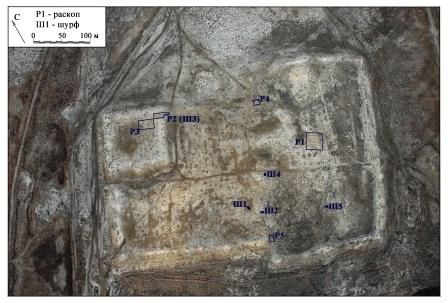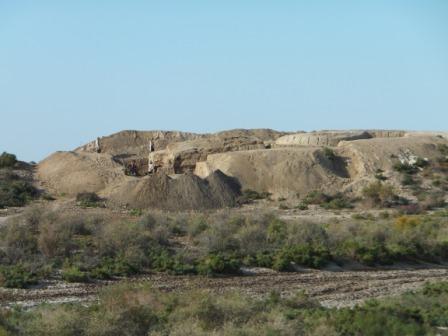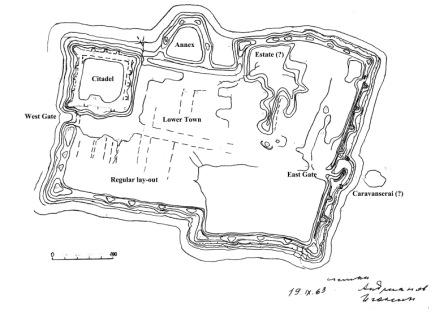Yanikand on:
[Wikipedia]
[Google]
[Amazon]
Jankent (Dzhankent, Yangikent, Eni-Kent, Djanikand, Yenikent, Yanikand, all meaning ''New Town'' in Turkic; al-Karyat al-hadith, Dihi Naw, Shehrkent) is a deserted town east of the
 Jankent was first mentioned by Russian army topographers in the early 19th century, and visited in 1867 by the orientalist P. Lerkh. In 1946, a team of the
Jankent was first mentioned by Russian army topographers in the early 19th century, and visited in 1867 by the orientalist P. Lerkh. In 1946, a team of the
 In the centre of the town, essential discoveries in Trench P1 included a built-up area (living quarters) with a lay-out in Central Asian style along a street, and a possible metal workshop, all dated to the 9th/10th centuries on the basis of coin finds. Later excavations in this area since 2011 have been carried out to a greater depth, revealing several building phases of earlier date.
In the centre of the town, essential discoveries in Trench P1 included a built-up area (living quarters) with a lay-out in Central Asian style along a street, and a possible metal workshop, all dated to the 9th/10th centuries on the basis of coin finds. Later excavations in this area since 2011 have been carried out to a greater depth, revealing several building phases of earlier date.
 At the junction of the citadel wall and northern town wall (Trench P2), occupation layers with complex stratification were found by the Russian-Kazakh-German team down to a depth of more than from the current top of the citadel wall. Radiocarbon dates from this trench produced a range of (cal.) AD 786/923 to 961/1095. The extension of the trench at the top of the citadel wall since 2012 has uncovered semi-circular towers on the wall. In 2019, a 9th/10th century pottery vessel from the outside of the northern base of the citadel wall was found to contain three eggs with Arabic writing on them.
Fieldwork in the interior of the citadel (Trench P3) by the Almaty and Pavlodar teams has reportedly uncovered only two layers of 9th/10th century date, the lower one of which produced building remains and a street. Lack of detailed publication precludes an independent verification of these claims.
At the junction of the citadel wall and northern town wall (Trench P2), occupation layers with complex stratification were found by the Russian-Kazakh-German team down to a depth of more than from the current top of the citadel wall. Radiocarbon dates from this trench produced a range of (cal.) AD 786/923 to 961/1095. The extension of the trench at the top of the citadel wall since 2012 has uncovered semi-circular towers on the wall. In 2019, a 9th/10th century pottery vessel from the outside of the northern base of the citadel wall was found to contain three eggs with Arabic writing on them.
Fieldwork in the interior of the citadel (Trench P3) by the Almaty and Pavlodar teams has reportedly uncovered only two layers of 9th/10th century date, the lower one of which produced building remains and a street. Lack of detailed publication precludes an independent verification of these claims.

 On the basis of their findings since 2011, the Russian-Kazakh-German team suggest that the earliest settlement at this site was founded in the 7th century by a displaced population of the
On the basis of their findings since 2011, the Russian-Kazakh-German team suggest that the earliest settlement at this site was founded in the 7th century by a displaced population of the
Jankent
{{Central Asian history History of the Turkic peoples Archaeological sites in Kazakhstan
Aral Sea
The Aral Sea ( ; kk, Арал теңізі, Aral teñızı; uz, Орол денгизи, Orol dengizi; kaa, Арал теңизи, Aral teńizi; russian: Аральское море, Aral'skoye more) was an endorheic basin, endorheic lake lyi ...
in modern Kazakhstan. It is known from Arab writings of the 10th century AD as the capital of the steppe empire of the Oghuz Turks
The Oghuz or Ghuzz Turks (Middle Turkic languages, Middle Turkic: ٱغُز, ''Oγuz'', ota, اوغوز, Oġuz) were a western Turkic people that spoke the Oghuz languages, Oghuz branch of the Turkic languages, Turkic language family. In th ...
. Archaeological research has provided information about the appearance of the town and confirmed the date, but also points to earlier origins.
Description
Jankent is located on the left bank of the lowerSyr Darya
The Syr Darya (, ),, , ; rus, Сырдарья́, Syrdarjja, p=sɨrdɐˈrʲja; fa, سيردريا, Sirdaryâ; tg, Сирдарё, Sirdaryo; tr, Seyhun, Siri Derya; ar, سيحون, Seyḥūn; uz, Sirdaryo, script-Latn/. historically known ...
, about southwest from the town of Kazaly (formerly Kazalinsk), in the Kazaly district of Kyzylorda province in Kazakhstan. Today, it is a scheduled monument marked by the ruins of walls which are up to high in places and enclose an area of in the dried-out river delta of the Syr-Darya. Visible elements of the lay-out include: a broadly rectangular wall circuit orientated east-west, given a T-shaped appearance by an eastern ‘cross-bar’; a regular lay-out in the western half of the interior; gates in the eastern and western walls; a separately enclosed ‘citadel’ in the north-western corner; a semicircular annexe attached to the northern wall; and a low mound outside the east gate suggesting an external structure.
Historical evidence
Arab geographers of the 10th century ( Al-Masudi, Al-Idrisi) mention a town of the Oghuz called Jengi-Kent, two sources ( Ibn Rustah and Ibn Hawqal) even call it the seat of the Oghuz Yabgu (khan of second rank). As early as the 1920s, the orientalist V.V. Bartold identified Jankent as the site of the historical Jengi-Kent. The town is also identified as the home town of the Kazakh cultural hero, Korkyt Ata, the reputed inventor of the traditional two-stringed lute (''kobyz'').Archaeological evidence
Chorasmian Expedition The Chorasmian Archaeological-Ethnographic Expedition of the Academy of Sciences (also known as Choresmian Expedition, Khorezmian Expedition) of the USSR explored a large area of Central Asia, where between 1937 and 1991, its members found and reco ...
surveyed the site and photographed it from the air. On the basis of the lay-out of the site and the finds collected during this visit, the director of the expedition, S.P. Tolstov, dated Jankent to the 1st – 11th centuries AD. Two other members of the expedition, N.I. Igonin and B.V. Andrianov, drew up an improved plan of Jankent in 1963.
Systematic excavations have been carried out at Jankent since 2005 by various teams, mainly the Institute of Ethnology and Anthropology, Russian Academy of Sciences (IEA RAN, Moscow) with Korkyt Ata State University of Kyzylorda (Kazakhstan) and the University of Tübingen (Germany); and the Margulan Institute of Archaeology, Kazakh Ministry of Education and Science (MON), later its commercial branch ‘Archaeological Expertise’ (Almaty, Kazakhstan), with Pavlodar State University (Kazakhstan).
Lower town
 In the centre of the town, essential discoveries in Trench P1 included a built-up area (living quarters) with a lay-out in Central Asian style along a street, and a possible metal workshop, all dated to the 9th/10th centuries on the basis of coin finds. Later excavations in this area since 2011 have been carried out to a greater depth, revealing several building phases of earlier date.
In the centre of the town, essential discoveries in Trench P1 included a built-up area (living quarters) with a lay-out in Central Asian style along a street, and a possible metal workshop, all dated to the 9th/10th centuries on the basis of coin finds. Later excavations in this area since 2011 have been carried out to a greater depth, revealing several building phases of earlier date.
Citadel
Town wall
A trench in the kink of the southern town wall (Trench P5) proved that the T-shaped lay-out of the wall circuit was part of the original design, similar to earlier enclosures further south in the neighbouring civilization ofKhorezm
Khwarazm (; Old Persian: ''Hwârazmiya''; fa, خوارزم, ''Xwârazm'' or ''Xârazm'') or Chorasmia () is a large oasis region on the Amu Darya river delta in western Central Asia, bordered on the north by the (former) Aral Sea, on the ...
( Chorasmia, Khwarazm). Settlement layers with 7th/8th century pottery were found here under the base of the town wall, confirmed by radiocarbon dates for this trench ranging from (cal.) AD 674/799 to 906/1057. An earlier trench (P4) in the corresponding kink in the northern wall is briefly mentioned, but not documented, in a summary report by the Almaty and Pavlodar teams.

Geophysics, geomorphology, soil science
Since 2011, a team from Moscow State University has applied several non-destructive survey techniques to large parts of the site. The results show that the citadel interior was probably located on a natural elevation. There was a regular lay-out and dense arrangement of buildings across much of the western half of the interior, in contrast to larger building complexes ('estates') in a loose arrangement in the eastern half. The annexe attached to the northern town wall proved to be completely empty. In 2019, a Moscow geomorphology-pedology team carried out mechanical coring on a grid across the site. Preliminary results include deep stratification of cultural layers several metres down found in most cores; the large regular feature on the inside of the northern wall is not an 'estate' (as originally thought), but a massive clay platform; and the substantial structure outside the east gate, hypothesized to be the remains of acaravanserai
A caravanserai (or caravansary; ) was a roadside inn where travelers ( caravaners) could rest and recover from the day's journey. Caravanserais supported the flow of commerce, information and people across the network of trade routes covering ...
, are a natural island in a (now dry) river bed dating to before the beginnings of settlement at Dzhankent.
Current state of knowledge
 On the basis of their findings since 2011, the Russian-Kazakh-German team suggest that the earliest settlement at this site was founded in the 7th century by a displaced population of the
On the basis of their findings since 2011, the Russian-Kazakh-German team suggest that the earliest settlement at this site was founded in the 7th century by a displaced population of the Dzhetyasar culture Dzhetyasar Culture (Jeti-Asar, Zhetiasar, from kaz. ''Seven (a lot of) fortresses'') - a group of settlements (possibly up to 100) from the end of the 1st millennium BC - 8th century AD, located in the northern part of the ancient Syrdarya and Ku ...
further upriver.Arzhantseva et al. (2012); Härke, H., Arzhantseva, I.A. and Tazhekeev, A. (2020). The early medieval town of Dzhankent (Kazakhstan): from initial hypothesis to new model. The European Archaeologist 66. 27-34. https://www.e-a-a.org/EAA/Publications/Tea/Tea_66/Research_news/EAA/Navigation_Publications/Tea_66_content/Research_news.aspx This coincided with the beginnings of trading activities along the early medieval branch of the Northern Silk Road running through this region. The enclosed town of Jankent was then built in the 9th or 10th century, some time after the arrival of the Turkic Oghuz on the steppes north of the Syr-darya. The town population may have been mixed as the material culture found at the site derives from three different cultural components: Oghuz nomads, sedentary Dzhetyasar culture, and Khorezmian civilization. In the 10th and 11th centuries, the town was the capital of the Oguz Yabgu State, and most likely it also functioned as a trading and craft centre for the largely nomadic population of the polity, being located on the intersection of the Northern Silk Road with the north-south caravan route from the Volga region to Khorezm
Khwarazm (; Old Persian: ''Hwârazmiya''; fa, خوارزم, ''Xwârazm'' or ''Xârazm'') or Chorasmia () is a large oasis region on the Amu Darya river delta in western Central Asia, bordered on the north by the (former) Aral Sea, on the ...
.
The town was abandoned some time between the 12th and 14th century AD for unknown reasons, perhaps because of a shift of the river channels in the Syr-Darya delta, a change in trading patterns, or because of political developments. Other Turkic peoples, the Kipchaks
The Kipchaks or Qipchaks, also known as Kipchak Turks or Polovtsians, were a Turkic nomadic people and confederation that existed in the Middle Ages, inhabiting parts of the Eurasian Steppe. First mentioned in the 8th century as part of the Se ...
and Kimeks
The Yemek were a Turkic tribe constituting the Kimek-Kipchak confederation, whose other six constituent tribes, according to Abu Said Gardizi (d. 1061), were the Imur (or Imi), Tatars, Bayandur, Kipchaks, Lanikaz, and Ajlad.
Ethnonym
Mino ...
of the Kimek Kaganate, destroyed the Oghuz polity in the 12th century. Around that time, Selçuk Bey and his Kınık
Kınık is a district of İzmir Province of Turkey
Turkey ( tr, Türkiye ), officially the Republic of Türkiye ( tr, Türkiye Cumhuriyeti, links=no ), is a transcontinental country located mainly on the Anatolian Peninsula in Western ...
tribe headed to Persia to found their own Muslim state which would eventually become the Great Seljuq Empire.
References
External links
* Great Soviet EncyclopediJankent
{{Central Asian history History of the Turkic peoples Archaeological sites in Kazakhstan